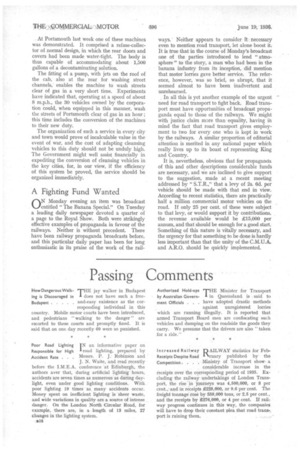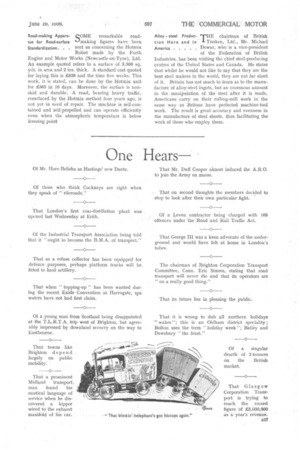Passing Comments
Page 26

Page 27

If you've noticed an error in this article please click here to report it so we can fix it.
HowDangerous WalkTHE jay walker in Budapest ing is Discouraged in I does not have such a free Budapest and-easy existence as the cor responding individual in this country. Mobile motor courts have been introduced, and pedestrians "walking to the danger" are escorted to these. courts and promptly fined. It is said that on one, day recently 69 were so punished.
Poor Road Lighting I N an informative paper on
Responsibre for High road lighting, prepared by Accident Rate . . . Messrs. P. J. Robinson and
J. N. Waite, and read recently before the I.M.E.A. conference at Edinburgh, the authors aver that, during artificial lighting hours, accidents are seven times as numerons'as during daylight, even under good lighting conditions. With poor lighting 19 times as many accidents occur. Money spent on inefficient lighting is sheer waste, and wide variations in quality are a source of intense danger. On the London North Circular Road, for example, there are, in a • length of 13 miles, 27 changes in the lighting system.
Authorized Hold-ups 'THE Minister for Transport by Australian GovernI in Queensland is . said to
ment Officials . . have adopted drastic methods against unregistered lorries which are running illegally. It is reported that armed Transport Board men are confiscating such vehicles and dumping on the roadside the goods they carry. We presume that the drivers are also "taken for a ride."
Increased Railway pilo AILWAY statistics for FebReceipts Despite Road I 1,ruary published. by the Competition. . . . Ministry of Transport show a considerable increase in the receipts over the corresponding period of 1935. Excluding the railway undertakings of London Transport, the rise in journeys was 4,500,000, or 8 per cent.,• and in receipts £228,000, or 9.6 per cunt. The freight tonnage rose by 559,000 tons, or 2.5 per cent., and the receipts by £276,000, or 4. per cent. If raili way progress continues in this way, the companies will have to drop their constant plea that road trans-, port is ruining them. . I , Road-making Apparatus for Road-surface Standardization. . . SOME remarkable roadmaking figures have been sent us concerning the Hotrnix Robot made by the Forth Engine and Motor Works (Newcastle-on-Tyne), Ltd. An example quoted refers to a surface of 3,360 sq. yds. in area and 2 ins, thick. A standard cost quoted for laying this is £838 and the time five weeks. This work, it is stated, can be done by the Hotmix unit for £305 in 10 days. Moreover, the surface is nonskid and durable. A road, bearing heavy traffic, resurfaced by the Hotnaix method four years ago, is not yet in need of repair. The machine is self-contained and self-propelled and can operate efficiently even when the atmospheric temperature is below freezing point Alloy steel Produc'THE chairman of British tion He re and in 1Timken, Ltd., Mr. Michael
America Dewar, who is a vice-president
of the Federation of British Industries, has been visiting the chief steel-producing centres of the United States and Canada. He states that whilst he would not like to say that they are the best steel makers in the world, they are not far short of it. Britain has not much to learn as to the manufacture of alloy-steel ingots, but an enormous amount in the. manipulation of the steel after it is made. Americans carry on their rolling-mill work in the same way as Britons have perfected machine-tool. work. The result is great accuracy and evenness in the manufacture of steel sheets, thus facilitating the work of those who employ them.




















































































